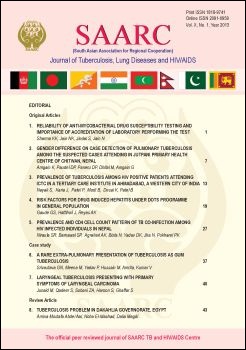Gender Difference on Case Detection of Pulmonary Tuberculosis Among the Suspected Cases Attending in Jutpani Primary Health Centre of Chitwan, Nepal
DOI:
https://doi.org/10.3126/saarctb.v10i1.8644Keywords:
Pulmonary Tuberculosis, Case Detection, Gender Difference, Suspected CasesAbstract
Introduction: Pulmonary tuberculosis is one of the World’s public health problems particularly in developing countries including Nepal. Every year, thousands of people suffered from active tuberculosis in Nepal; of whom 50 percent have infectious pulmonary tuberculosis. It is more common among men than women, and affects mostly adults of economically productive age. There is scantiness of such information in Nepal. Hence the study was carried out to identify the gender difference on case identifi cation of pulmonary tuberculosis in Chitwan district of Nepal.
Methodology: Descriptive cross sectional study was carried out from July to December 2012 in Jutpani Village Development Committee of Chitwan, Nepal. All symptomatic cases attending in Jutpani Primary Health Center with the clinical history pulmonary tuberculosis were included. Microscopic examination of sputum samples of three consecutive days was done for AFB. Results were disseminated in tabular, graphical and narrative form using appropriate statistics.
Results: Total 200 suspected cases of pulmonary tuberculosis were included in this study; among them 18 (9%) were found to be AFB positive. Sex ratio of diagnosed patients was 5:4 (male; 55.56% and female; 44.44%). Highest prevalence of TB infection (36.89%) was found in 30-40 years age. Highest number of cases 5 (27.78%) were reported in the ward number four (male female ratio; 3:2). One-third of cases were in July followed by 22.22% in each of the month; August and September.
Conclusion: Males were found to be more likely to have pulmonary tuberculosis than females. Gender specifi c case identifi cation and preventive measure targeting to the most productive age group population will eventually supports to reduce the risk of pulmonary tuberculosis.
SAARC Journal of Tuberculosis, Lung Diseases & HIV/AIDS; 2013; X(1); 7-12
Downloads
Downloads
Published
How to Cite
Issue
Section
License
Copyright © SAARC Tuberculosis and HIV/AIDS Centre (STAC), all rights reserved, no part of this publication may be reproduced, stored in a retrieval system or transmitted in any form or by any means without prior permission of the STAC.





